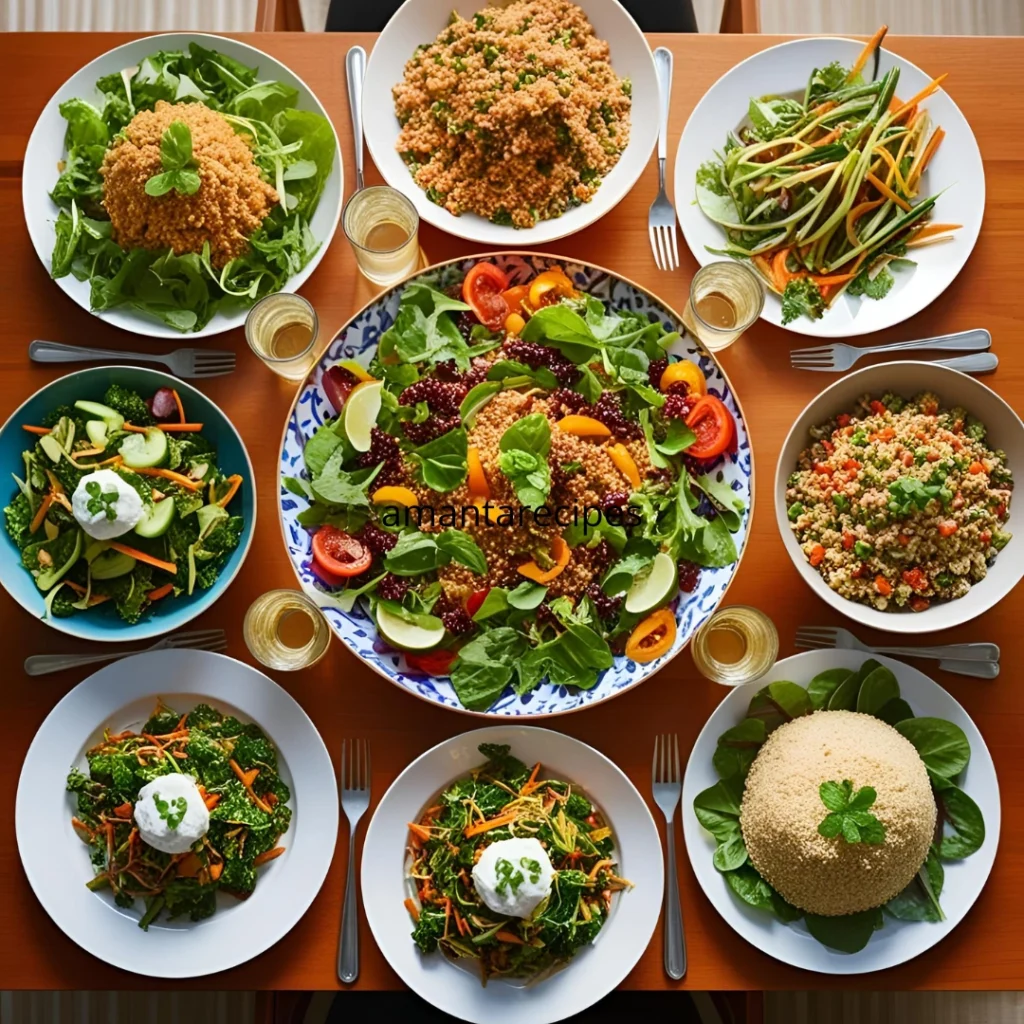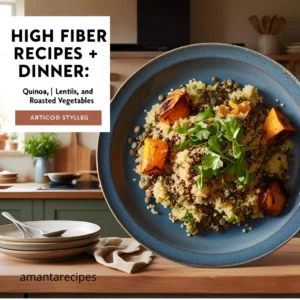Table of contents
What’s for Dinner? Discover the Secret to Quick, Healthy High Fiber Meals
Are you tired of spending hours in the kitchen only to end up with bland, unhealthy meals? What if I told you there’s a way to enjoy dinner that’s not only delicious but also packed with fiber, nutrients, and health benefits—all in under 30 minutes? Enter high fiber recipes for dinner—a game-changer for busy weeknights. In this article, we’ll show you how to whip up easy, nutritious dinners that will keep you full, energized, and satisfied.
Why Choose These High Fiber Recipes?

These recipes are special because they’re designed with simplicity and speed in mind. Whether you’re juggling work deadlines or shuttling kids to after-school activities, these meals take less than 30 minutes to prepare and require minimal effort. Even better, they’re beginner-friendly, so even if you’re new to cooking or short on culinary skills, you’ll find them approachable and fun to make.
The best part? You can customize every element to suit your taste preferences. From hearty grain bowls to veggie-packed stir-fries, there’s something here for everyone. Plus, these recipes are loaded with fiber, which supports digestion, keeps you feeling full longer, and promotes overall gut health .
Essential Ingredients: The Building Blocks of High Fiber Dinners
Before diving into the recipe, let’s talk about the star players in high-fiber cooking. These ingredients aren’t just healthy—they’re also versatile and delicious:
- Whole Grains: Quinoa, brown rice, farro, and whole-wheat pasta are excellent sources of fiber. They add bulk to your meal and keep you full longer.
- Legumes: Beans, lentils, and chickpeas are nutritional powerhouses, rich in protein and fiber. Use them as a base or mix them into soups and salads.
- Vegetables: Leafy greens like spinach and kale, cruciferous veggies like broccoli and cauliflower, and starchy options like sweet potatoes provide essential nutrients and fiber.
- Fruits: Apples, pears, and berries can be added to savory dishes for natural sweetness and extra fiber.
- Nuts and Seeds: Almonds, chia seeds, and flaxseeds add crunch and healthy fats while boosting fiber content.
- Herbs and Spices: Fresh herbs like parsley, cilantro, and basil elevate flavor without adding extra calories.
Substitutions and Variations
Don’t have quinoa? Swap it out for brown rice or barley. Hate broccoli? Try roasted Brussels sprouts instead. The beauty of high-fiber recipes lies in their flexibility—you can tweak them endlessly based on what’s in your pantry.
Step-by-Step Instructions: Building Your Perfect High Fiber Dinner
Now comes the fun part—actually making the dish! Follow these simple steps to create your own high fiber masterpiece.
Step 1: Prep Your Base
Your base is the foundation of your meal. For most high-fiber dinners, this means grains or legumes. Here’s how to do it:
- Cook quinoa according to package instructions (usually 1 cup quinoa + 2 cups water). Fluff with a fork when done.
- Alternatively, boil lentils or chickpeas until tender—or use canned versions for convenience.
Pro Tip: Batch-cook your grains and legumes at the start of the week to save time during assembly.
Step 2: Roast or Sauté Your Veggies
Roasted vegetables add depth and sweetness to your dish. Here’s an easy method:
- Chop veggies like bell peppers, zucchini, and broccoli into bite-sized pieces.
- Toss with olive oil, salt, pepper, and garlic powder.
- Spread evenly on a baking sheet and roast at 400°F for 15–20 minutes until tender and slightly caramelized.
If you’re short on time, sautéing works just as well. Heat a skillet over medium heat, add olive oil, and toss in your chopped veggies until softened.
Step 3: Add Protein Power
Choose your protein source based on your dietary needs:
- For vegetarian options, use tofu, tempeh, or boiled eggs.
- If you prefer meat, grill chicken breast or bake salmon fillets seasoned with paprika, lemon zest, and black pepper.
Step 4: Whip Up a Simple Sauce
No high-fiber dish is complete without a flavorful sauce. Try one of these:
- Tahini Dressing: Mix tahini paste, lemon juice, minced garlic, and a pinch of salt. Thin with water until pourable.
- Lemon-Olive Oil Vinaigrette: Combine olive oil, lemon juice, Dijon mustard, and honey for a bright, zesty finish.
Assembly: Bringing It All Together
Once all your components are ready, it’s time to assemble your dish. Follow these tips for maximum impact:
- Start with your base (grains or legumes).
- Layer on roasted or sautéed veggies.
- Add your protein source.
- Sprinkle toppings like toasted nuts, seeds, or crumbled feta cheese for extra flavor.
- Drizzle generously with your chosen sauce.
- Garnish with fresh herbs like parsley or cilantro for a pop of green.
For presentation, aim for a rainbow effect—variety in colors makes your plate visually appealing and appetizing.
Storage and Make-Ahead Tips
One of the greatest advantages of high-fiber recipes is their versatility for meal prep. Here’s how to store and reheat your creations:
- Store each component separately in airtight containers. This keeps everything fresh and prevents sogginess.
- Reheat proteins and grains gently in the microwave or stovetop. Avoid reheating greens; they’re best enjoyed cold.
- Assemble your dish right before eating to maintain freshness and texture.
Recipe Variations: Get Creative!
Feel free to experiment with different combinations to keep things exciting:
- Stir-Fry Twist: Use soba noodles as your base and toss with soy sauce, ginger, garlic, and stir-fried veggies.
- Soup Option: Simmer lentils, diced tomatoes, spinach, and vegetable broth for a comforting bowl of goodness.
- Sheet Pan Meal: Roast chickpeas, sweet potatoes, and broccoli on a single pan for a fuss-free dinner.
Conclusion: A Healthier Dinner Awaits
With these easy high-fiber recipes for dinner, you’re well-equipped to create meals that are as nutritious as they are delicious. Not only will you save time, but you’ll also nourish your body with wholesome ingredients. So why wait? Head to your kitchen today and start experimenting with these ideas. Bon appétit!
FAQs About High Fiber Recipes for Dinner
Q: Are these recipes suitable for vegetarians?
A: Absolutely! Most high-fiber dishes can easily be adapted for vegetarian diets by swapping meat for plant-based proteins like beans, lentils, or tofu.
Q: Can I freeze any of these components?
A: Yes! Cooked grains, lentils, and roasted veggies freeze well. Just thaw overnight in the fridge before using.
Q: How healthy are high-fiber dinners?
A: Very! They’re rich in fiber, which supports digestion, heart health, and weight management. Plus, they’re packed with vitamins and minerals.
Q: What if I don’t have all the ingredients?
A: No problem! High-fiber recipes are highly adaptable. Use what you have on hand and adjust seasonings to taste.Q: Can I make these recipes kid-friendly?
A: Definitely! Kids love colorful foods. Try cutting veggies into fun shapes or serving dips like hummus alongside crackers or veggie sticks.

